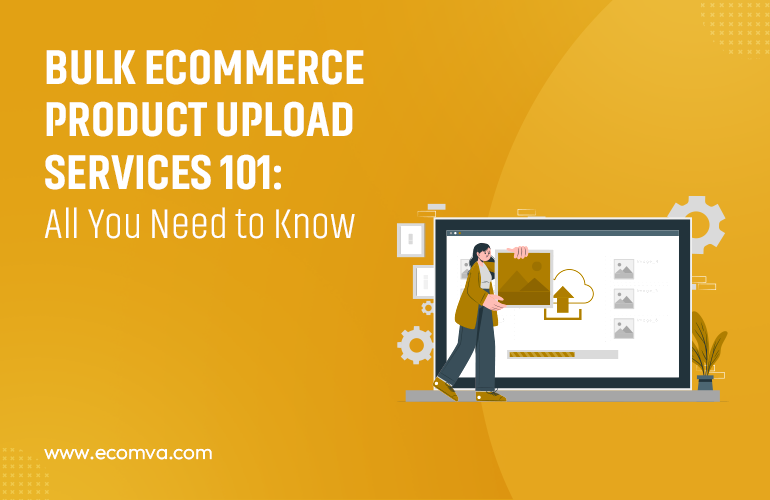Bulk Ecommerce Product Upload Services 101: All You Need to Know

In the rapidly expanding E-commerce landscape, efficient bulk product upload is crucial for scaling your business.
Imagine trying to upload thousands of products manually—not only is it tedious, but it’s also a recipe for errors. Bulk product upload services eliminate these challenges, offering speed, accuracy, and scalability. Whether you’re a small retailer or managing a multi-platform empire, efficient bulk E-commerce product upload ensures your store is always ready for customers, leaving you free to focus on driving sales and innovation.
Let’s delve into why this process is a cornerstone of modern E-commerce success and how it can transform your operations:
What Are Bulk E-commerce Product Upload Services?
Running an online store is no small feat, especially when it comes to uploading products. Bulk E-commerce product upload services make this process seamless, enabling businesses to add hundreds—or even thousands—of products in one go. Instead of manually entering data, you upload a single file, like a CSV or Excel sheet, packed with all the details. This approach saves time, reduces errors, and gets your store ready for customers faster.
Common Challenges in Product Uploads
Uploading products is often more challenging than it seems. Here’s what businesses frequently face:
| Challenges | Impact |
|---|---|
| Manual Data Entry | Prone to errors, slow, and resource-intensive. |
| Handling Variations | Managing sizes, colors, and other options can be overwhelming. |
| Image Linking and Formatting | Ensuring every product has the correct, optimized image is tedious. |
| Platform-Specific Guidelines | Adapting data to meet each platform’s unique requirements takes effort. |
Each of these issues can slow you down, affect customer experience, or even hurt sales.
How Bulk Upload Services Streamline the Process?
Bulk product upload services address these challenges head-on. Here’s how they make a difference:
- Centralized Data Management: By using a single spreadsheet for all product details, you eliminate the chaos of scattered information.
- Error Reduction: Automated processes validate data, reducing the chances of mistakes like duplicate entries or missing values.
- Multi-Platform Integration: Whether you use Shopify, WooCommerce, or Amazon, these services adapt to platform-specific rules.
- Time Savings: What might take days manually can be completed in hours with bulk uploads.
- Image Optimization: Services ensure images are properly sized, formatted, and linked to each product for a polished store look.
Imagine preparing your product catalog in one file and uploading it in a few clicks. This convenience is what makes bulk product upload services essential for modern E-commerce.
Key Features of Professional Bulk Upload Services
Here’s what makes these services indispensable:
Platform Compatibility
Professional bulk upload services ensure compatibility with leading platforms, including Shopify, Amazon, and WooCommerce. They adapt to each platform’s specific guidelines, making integration seamless and hassle-free.
Data Accuracy and Validation
Errors and inconsistencies can disrupt your store. These services perform rigorous data validation to eliminate duplicates, missing fields, or incorrect formatting, ensuring a clean and precise upload process.
Managing Variations
Handling variations, such as size, color, or material, can be challenging.Bulk product upload services streamline this process, allowing you to list all variations under a single product entry. Customers can easily select their preferred options, improving user experience.
Image Optimization
Images play a vital role in conversions. Bulk services handle bulk image uploads and optimization, ensuring consistent resolution, size, and format. This step enhances visual appeal and reduces page load times, boosting customer satisfaction.
| Feature | Benefits |
|---|---|
| Platform Compatibility | Supports major platforms, ensuring seamless integration. |
| Data Accuracy and Validation | Removes duplicates, fixes errors, and maintains data integrity. |
| Managing Variations | Simplifies adding sizes, colors, and other options. |
| Image Optimization | Enhances image quality while reducing load times for better performance. |
Benefits of Outsourcing Bulk Product Upload Services
Outsourcing bulk uploads offers several advantages:
Time and Cost Savings
Uploading large product catalogs manually is tedious and expensive. Bulk product upload services automate the process, saving you valuable hours and reducing operational costs. Businesses can allocate resources more efficiently and focus on strategic goals.
Enhanced Accuracy
Data errors can harm your reputation and affect sales. By outsourcing to experts, you benefit from precise E-commerce data upload processes. Professionals conduct thorough quality checks, ensuring every product meets platform standards and customer expectations.
Access to Expertise
Experienced providers understand the unique demands of different platforms. Whether it’s Shopify, Amazon, or WooCommerce, they manage multi-platform requirements effectively. Their expertise ensures smooth transitions, even for complex catalogs. These services also simplify product catalog management for better results.
Comprehensive Solutions
Many providers offer end-to-end services, including eCommerce product management, bulk image optimization, and handling variations. These all-in-one solutions are perfect for growing businesses seeking streamlined operations.
| Benefits | Details |
|---|---|
| Time and Cost Savings | Reduces manual effort and operational expenses. |
| Enhanced Accuracy | Ensures error-free uploads with proper validation and compliance. |
| Access to Expertise | Leverages knowledge of multi-platform requirements for seamless integration. |
| Comprehensive Solutions | Covers all aspects of data entry, image uploads, and catalog management. |
Step-by-Step Guide to Bulk Product Upload
Platform Specifics (Magento, Shopify, etc.)
Step 1: Familiarize Yourself with the Platform
The first and most crucial step involves getting well-versed in the nuances and requirements of your chosen E-commerce platform. It can be Shopify, Magento, etc. Each platform tends to have particular formats and fields for the product data.
Step 2: Access the admin dashboard
After that, you should consider logging in to the admin dashboard of your E-commerce product upload services platform. It is where you will initiate the product upload procedure.
Step 3: Navigate to the Product Upload Section
The subsequent step is locating the tool or section within the admin panel dedicated to product uploads and management. You will be able to commence the process of bulk uploading in this product upload section.
Step 4: Review Platform Documentation
As a part of this step, you should focus on reviewing the platform’s official documentation or support resources. It will help you learn about the specific guidelines and best practices related to product uploads.
Uploading via CSV or Excel
Step 5: Prepare Product Data File
The next step is creating a Comma Separated Values, CSV, or Excel spreadsheet file. It typically contains all the critical product information. In this regard, you should ensure that the file format aligns well with the platform’s specific requirements.
You can get in touch with reliable virtual assistant services if you need any related assistance.
Step 6: Match Data Fields
As a part of this step, you should focus on mapping the columns in your data file to the corresponding fields in the platform. You can expect to see this option in the upload tool, this step helps ensure the platform identifies and processes each data point correctly.
Step 7: Verify Data Accuracy
Before you finalize the E-commerce product upload process, you must double-check the data to ensure completeness and accuracy. This data typically includes product descriptions, names, categories, prices, and other attributes.
Step 8: Begin the Upload
Now, you should focus on leveraging the upload tool of the platform to begin the bulk product upload. Also, follow the prompts and confirm the action to start the process.
Step 9: Monitor Progress
After that, you need to closely monitor the upload progress, based on the size of your catalog, this specific process may take some time.
Troubleshooting Common Issues
Step 10: Handling Data Errors
Any inconsistencies or errors may arise during the upload process. If you encounter any such issues, you need to refer to the error logs or notifications offered by the platform. Make sure to read this well to address and find out any problem in the data file.
Step 11: Addressing Image Upload Problems
You should ensure the images are appropriately linked to the corresponding products, Along with that, you also need to verify that file paths or image URLs are accurate.
Step 12: Resolving Formatting Problems
In this step, you are required to closely examine to find if there are any formatting discrepancies between the platform’s requirements and your data file. Also, make necessary adjustments in data types or column formats as required.
Step 13: Dealing with Duplicate Entries
Now, it is the time to effectively address any duplicate entries that may happen during the upload process. Consider merging or removing duplicate products as per the requirement.
Step 14: Handling Category Assignments
In this step, you must confirm whether the products are assigned to the appropriate categories, If required, you should consider adjusting category assignments within the platform.
To successfully navigate this step, you can opt for E-commerce product store management services.
Step 15: Verifying Pricing and Inventory
As a part of this step, you should double-check pricing and inventory levels to ensure accuracy. Depending on the requirement, you can directly make any adjustments within the platform.
Step 16: Seek Platform Support or Resources
Finally, you can contact the support resources, community, or forums of the platform if you encounter persistent problems. You can even reach out to the platform’s support team for further assistance.
Best Practices for Bulk E-commerce Product Upload
Preparing and Organizing Data
Ensure your product data is well-structured and complete. Use detailed spreadsheets with columns for product names, SKUs, descriptions, categories, and prices. Double-check the consistency of all fields to avoid discrepancies during the upload.
Using CSV Templates Effectively
Most E-commerce platforms provide CSV templates for bulk uploads. Familiarize yourself with the required fields and formats. Fill out the template with accurate product details, ensuring the data aligns with platform-specific guidelines.
Optimizing Product Descriptions
Create concise yet engaging product descriptions. Highlight key features and benefits, naturally incorporating relevant keywords like bulk E-commerce product upload and E-commerce data upload to improve search visibility. Include high-resolution images with proper alt text for enhanced SEO.
Ensuring Marketplace Compliance
Adhere to marketplace rules to avoid listing errors or penalties. Review platform-specific requirements for titles, images, descriptions, and pricing. Following these standards ensures a seamless E-commerce product upload service experience.
| Best Practice | Why It Matters |
|---|---|
| Organizing Product Data | Ensures a smooth upload process and accurate inventory management. |
| Using CSV Templates | Simplifies the upload process and reduces errors. |
| Optimizing Descriptions | Improves product visibility and enhances customer engagement. |
| Ensuring Compliance | Avoids listing errors and maintains platform credibility. |
When to Consider Professional Bulk Upload Services?
You should consider bulk E-commerce product upload services in the following scenarios:
Scaling Inventory Rapidly
When your business is growing, and you need to add thousands of products, manual uploads can slow down your progress. Professional services help you manage large inventories quickly and efficiently.
Entering New Marketplaces
Expanding your business to platforms like Shopify, Amazon, or WooCommerce requires compliance with their unique guidelines. Using multi-platform product upload services ensures your listings meet these requirements, enabling a smooth entry into new markets.
Upgrading Product Catalogs
Refreshing or updating your catalog can be overwhelming. Outsourcing product upload tasks ensures accurate and efficient updates, whether it’s revising product descriptions, pricing, or adding new images.
| When to Consider | Reasons |
|---|---|
| Scaling Inventory Rapidly | Handle large product volumes efficiently and reduce manual effort. |
| Entering New Marketplaces | Ensure compliance with platform-specific guidelines for seamless integration. |
| Upgrading Product Catalogs | Simplify updates to descriptions, images, and pricing. |
EcomVA offers tailored solutions for your business needs.
Choosing the Right Bulk Upload Service Provider
Key Criteria to Evaluate
When selecting the right provider for bulk Ecommerce product upload, consider these essential factors:
- Experience: Ensure the provider has a proven track record with businesses in your niche.
- Platform Expertise: Verify their familiarity with platforms like Shopify, Amazon, WooCommerce, and others.
- Turnaround Time: Fast delivery ensures your products go live without delays.
- Customization: Opt for providers offering tailored solutions that fit your unique needs.
- Data Security: Confirm robust measures to safeguard your sensitive information.
Reviews and Case Studies
Look for reviews or case studies highlighting successful projects. These provide insights into the provider’s reliability, efficiency, and quality of service. Positive testimonials indicate trustworthiness and expertise.
Why Choose EcomVA?
EcomVA stands out for its exceptional services. With expertise in bulk product upload services, they ensure accuracy, timely delivery, and compatibility with major platforms. Their tailored approach ensures businesses achieve their E-commerce goals effectively.
| Criteria | What to Check |
|---|---|
| Experience | Proven track record in the E-commerce industry. |
| Platform Expertise | Knowledge of major platforms like Shopify and Amazon. |
| Turnaround Time | Fast service to meet business deadlines. |
| Customization | Tailored solutions for unique business needs. |
| Data Security | Advanced measures to protect sensitive information. |
Learn why EcomVA is a trusted provider.
Conclusion
Bulk E-commerce product upload services are indispensable for scaling businesses. They ensure accurate uploads, save time, and allow for seamless platform integration. By adopting these services, businesses can focus on growth without getting bogged down by tedious tasks.
EcomVA offers tailored bulk product upload services that cater to businesses of all sizes. Their expertise spans multiple platforms, ensuring high-quality E-commerce data upload and catalog management. Partnering with EcomVA can simplify your operations and set you on the path to success.
Explore the benefits of outsourcing your bulk uploads and see how EcomVA can elevate your E-commerce journey.
FAQs
1. What file formats are supported for bulk uploads?
CSV and Excel files are the most commonly accepted formats for bulk E-commerce product upload.
2. Can product variations like size or color be included in bulk uploads?
Yes, bulk product upload services handle variations efficiently, ensuring all options are correctly listed.
3. What measures ensure error-free uploads?
Experts validate data for duplicates, inconsistencies, and missing fields, ensuring a seamless E-commerce data upload process.
4. Are these services compatible with all E-commerce platforms?
Most providers support major platforms like Shopify, Amazon, WooCommerce, and others, offering multi-platform product upload services.
5. Why should businesses consider outsourcing bulk uploads?
Outsourcing simplifies the process, saves time, and ensures high-quality results with the help of experienced professionals.











